Soaring to Panama
Posted on in In the Field by Dr. Laurie Goodrich, Director of Long-term MonitoringDr. Laurie Goodrich, Director of Long-term Monitoring
Read Part 2 by Jamie Dawson here
Panama. I am finally here. Since I was a university student I have longed to visit here, enticed by reading the landmark tropical ecology studies that occurred here at sites such as Panama Canal Zone, Pipeline Road, and Canopy Tower. Later on, as a hawkwatcher, I read of Ancon Hill and the clouds of Swainson’s hawks and turkey vultures swirling above Panama City, and a new “bucket list” place was born.
On October 19, five of the Hawk Mountain 2018 Panama eco-tour members arrived at night to await the start of the Hawk Mountain tour to Panama the following day, with Raptours and raptor expert/former Hawk Mountain trainee Sergio Seipke. Arriving in the dark, my first impression of Panama City was, ”…Wow, this is larger than I imagined.” The city lights illuminated towering skyscrapers, boldly lit casinos, and bustling streets.
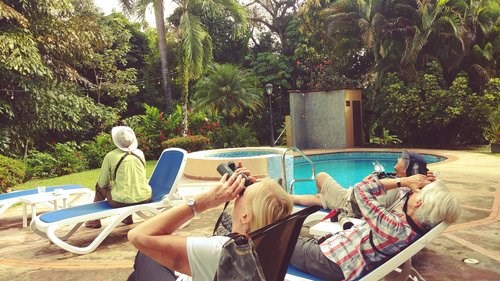
We gathered near the pool for bird-watching and breakfast the next morning. Sergio pointed out a three-toed sloth sleeping in the tree next to the porch, and soon small flocks of crimson-backed tanagers, thick-billed euphonia, and other tropical birds flitted around us. By 7:30 am, hundreds of broad-winged hawks rose up over the hotel, circling low and streaming to the northeast. Swainson’s hawks, Mississippi kites, and black and turkey vultures, joined the flow along with short-tailed hawk and hook-billed kite. Hundreds of common nighthawks glided overhead along with clouds of barn and cliff swallows as well, all possibly having passed over Pennsylvania in weeks past.
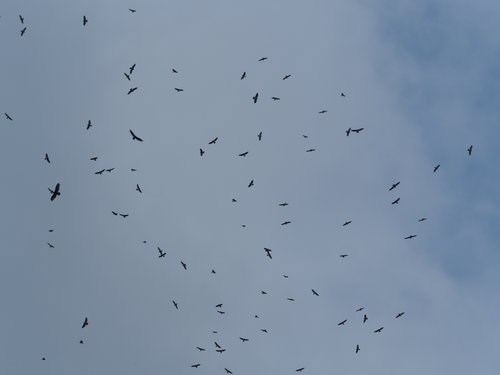
During the late morning, continued streams of broad-winged hawks and turkey vultures sailed overhead. Patty, a female Broad-winged Hawk from northwest Pennsylvania that we had satellite-tagged in 2016, had roosted just 11 km west of our location on the night before. I was sure she soared above us that morning amid the 50 thousand broadwings we tallied over our hotel, and her satellite-tracked pathway confirmed my suspicion!
The following morning the full 14 member group met up with our Panama bird guide for the tour, Domi, Domiciano Alveo, who along with Sergio of Raptours made sure we saw every bird. After a morning of watching tropical kingbirds, chachalacas, and other new birds, we spent the morning hawk-watching within view of the Panama Canal and the famed Ancon Hill. We watched streams of birds rising off the hills west of town and flying towards us. Contrary to our North American bias, south-bound raptors fly northeast to traverse Panama City and avoid crossing water.
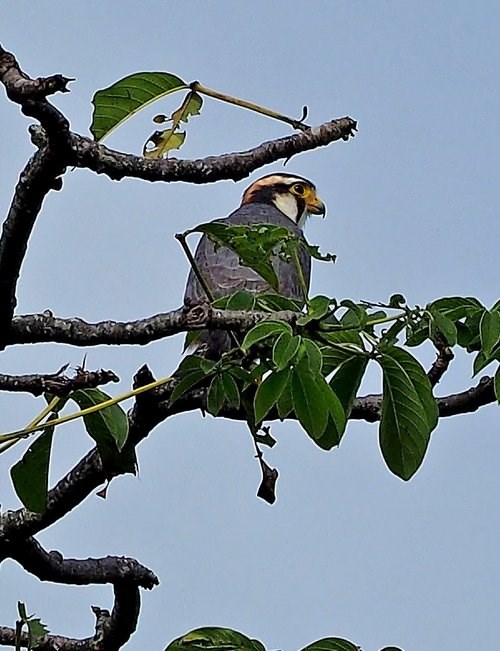
The next day we explored the impressive Miraflores Locks- Panama Canal museum. We stood on a fourth floor deck overlooking massive freighters inching their way through the locks. From the deck, we spotted a king vulture soaring and a bat falcon hunting from the Canal Zone light fixtures.
For the next few nights we stayed at the Canopy Lodge, an amazing eco-lodge immersed in forest aside a fast-flowing stream with fruit feeder trays and hummingbird feeders adjacent to large open deck. Experienced guides lingered to point out birds and a comfortable sitting area welcomed us to never leave. During our days we explored the surrounding region and visited the Pacific Ocean. Small clouds of raptors were seen nearly everywhere in the central mountains. On the Pacific slope, we had one incredible view of an aplomado falcon perched alongside the road and savannah hawks hunting with egrets in wet meadows. Other birds included a roadside hawk, crane hawk, and white-tailed kite.
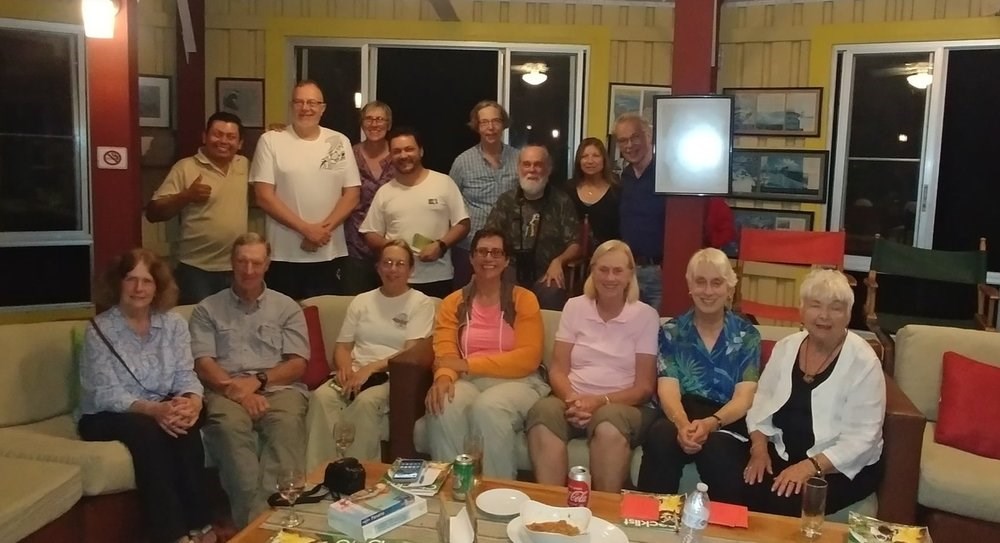
We then moved to another famed eco-lodge, the Canopy Tower. Here we were greeted by well-known nature and bird guide, Carlos Bethancourt, who along with the staff treated our group as kings and queens. The Canopy Tower was built in 1960s as part of the radar defense system for the Panama Canal and was also used to detect drug-carrying planes in the 1980s. In the 1990s it was transferred to visionary Raul Arias de Para who renovated it into a center for neotropical-rainforest ecotourism. Today the Tower has a hawk-watching deck and hosts bird-watchers in overnight rooms set into the sides of the circular tower. Rain was a daily companion for us and dampened some of our hawkwatching, however side trips were amazing and included a visit to the famed Pipeline Road, Rainforest Discovery Center and a boat trip on the Canal.
I gained a new appreciation for the trials of migration through Central America as each day rain blocked flights or kept flocks of hawks fighting for lift. After a cloud burst rain amid the forested hills, we watched an immature broad-winged hawk plummet into the treetops to perch, drenched and wet and looking thoroughly dejected. As sun tried to emerge, it spent 40 minutes trying to preen its feathers before it finally circled up to try to migrate again.
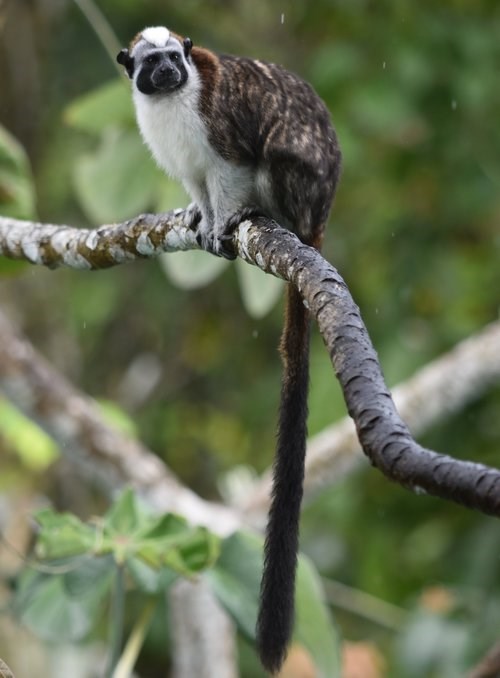
Tropical Mammals were a treat to see. At the Tower, Geoffroy’s Tamarin monkeys lingered near the upper deck staring at people, hoping for banana gifts, while white-nosed coati and howler monkeys occasionally passed by. White-faced capuchin troops were seen occasionally and three-toed sloths were spotted nearly every day.
Each morning an optional pre-dawn gathering occurred outside the Tower, complete with fresh-brewed coffee and tea. Sergio and Domi stood quietly in the dark attempting to call in one of the elusive forest falcons. Mostly the forest was quiet until dawn wakened the hummingbirds to hover at nearby feeders. On the last morning we met at 5:30 am hoping for the best. After about 20 minutes, suddenly Sergio leaped to his feet and motioned us off the deck to the driveway below. Soon, not one but all three forest falcon species were heard--collared, slaty-backed and barred forest-falcons! For me hearing those rare species was the icing on the cake for a wonderful trip. For the main tour we tallied 39 raptor species and 253 total birds, despite enduring torrential downpours on part of every day. We enjoyed amazing views of broad-winged and Swainson’s hawks kettling over the rugged hills of Panama, and, I checked off a lifetime bucket list place.
This blog is dedicated to Hawk Mountain volunteer, Karen Davidheiser, who accompanied us on several eco-tours in recent years. Stay tuned for Part 2, which will tell the dramatic tale of the extension portion of this eco-tour!